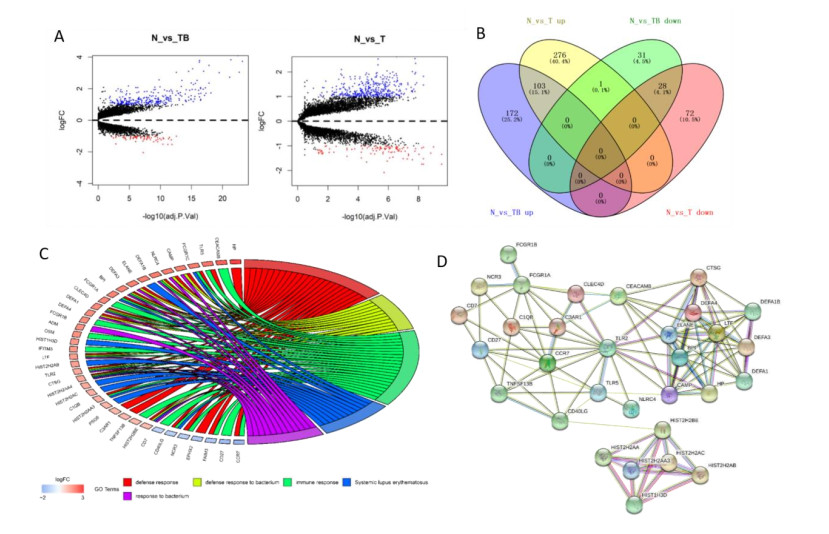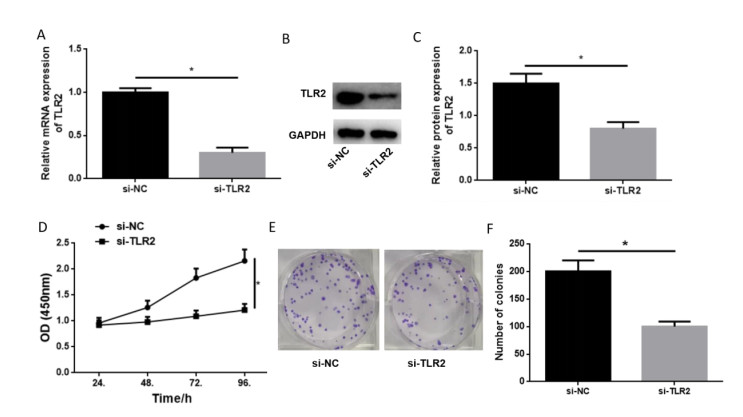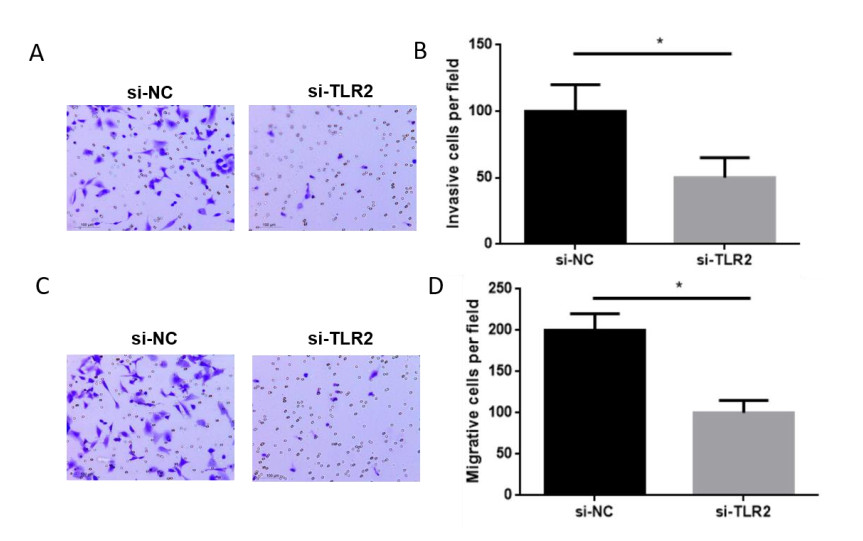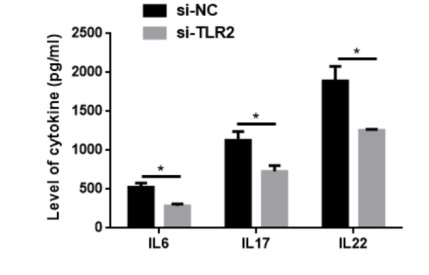1.
Introduction
Lung cancer is one of the most common and deadly tumor diseases worldwide [1]. Although great progress has been made in early detection and treatment, the current prognosis of patients is still poor with a 5-year survival rate of less than 20%
[2,3]. About 300,000 people are diagnosed with lung cancer and about 250,000 people die from lung cancereach year in China [4]. Pulmonary tuberculosis is a respiratory infection caused by the Mycobacterium tuberculosis complex, which is a serious threat to human health.In 2017, there are an estimate 10 million new cases of tuberculosis and 1.3 million deaths from tuberculosis worldwide, and China is one of the countries with high incidence of tuberculosis [5].
There has long been a view that the occurrence and development of tumors is accompanied by inflammation [6,7]. With the development of tumors, the inflammatory microenvironment plays an important role in tumor growth and metastasis [8]. After M. tuberculosis is phagocytosed by macrophages, pathogenically related molecular patterns (PAMPs) of M. tuberculosis bind to macrophage pattern recognition receptors (PRRs), which promotes the release of inflammatory cytokines and the expression of adhesion molecules, and further recruits more macrophages and APCs into the site of infection, thereby promoting inflammation [9]. Therefore, more and more researchers linked lung cancer research to tuberculosis, especially in the diagnosis of tuberculosis and lung cancer [10,11,12,13].
Toll-like receptors (TLRs) are pattern recognition receptors (PRRs) that recognize a variety of pathogen-associated molecular patterns (PAMPs) [14]. As an innateimmune receptors, TLRs are involved in the identification of tissue damage and inflammation associated with microbes and autoligands [6]. For example, TLR4 signaling in the tumor microenvironment of immune and inflammatory cells might lead to the production of pro-inflammatory cytokines (TNF, IL-1β, IL-6, IL-18, etc.), immunosuppressive cytokines (IL-10, TGF-β, etc.) and angiogenic media (VEGF, EGF, TGF-β, etc.) [6]. However, the current research on TLRs in lung cells or lung cancer cells is still limited.
In the present study, the levels of TLR2 and related factors in the serum of patients with tuberculosis and lung cancerwere examined and compared, and transfected cell lineswere constructed to verify the relationship between TLR2 expression and cell function changes in lung cancer cell proliferation, migration and invasion.It lays a good foundation for further research on whether TLR2 affects tuberculosis transformation or promotes lung cancer.
2.
Material and methods
2.1. General material
From February 2017 to February 2018, all hospitalized patients had no history of diabetes, hepatitis and other immune system diseases, and no history of use of hormonal drugs and immunosuppressants. Tuberculosis patients with negative tuberculin test (PPD) excluded the possibility of non-reactivity of the tuberculin.
Tuberculosis group: 47 cases in total, were newly diagnosed and hospitalised as tuberculosis, no anti-tuberculosis treatment or the hospitalized anti-tuberculosis treatment was within 1 week, all received a 5U PPD skin test within 1 week before blood draw. The diagnosis of tuberculosis is based on the current tuberculosis classification and classification standards revised in 1998. There were 29 males and 18 females; aged 16–78 years, average age was (39.02 ± 11.08) years old. Sputum concentration: Positive 36 cases, negative 11 cases; PPD ≤ 2+: 22 cases, PPD > 2+: 16 cases, PPD negative: 9 cases.
Lung cancer group: 55 cases in total, which were newly diagnosed as lung cancer, did not receive radiotherapy and chemotherapy and interventional therapy and confirmed through pathology. There were 36 males and 19 females; aged 16–78 years, average age was (55.96 ± 11.59) years; 21 cases of adenocarcinoma, 11 cases of squamous cell carcinoma, 6 cases of squamous adenocarcinoma, 9 cases of small cell lung cancer, 8 cases of non-small cell lung cancer.
Control group: 31 healthy physical examinees, 13 males and 18 females; aged 16–74 years, average age was (43.5 ± 14.51) years old; inclusion criteria: No history of other chronic diseases such as tuberculosis; no recent infectious symptoms like fever; no recent immunosuppressive taken history of glucocorticoids such as glucocorticold; no autoimmune disease history such as rheumatoid arthritis or cupus erythematosus.
2.2. Serum sample collection and ELISA
The 3 mL of fasting venous blood in the morning was taken, placed in a refrigerator at 5 ℃ for 24 h, transferred to a centrifuge (Eppendorf, Germany), centrifuged at 2000g for 10 min to extract serum, and stored at -80 ℃ for use. The expression levels of TLR2, IL6, IL17, and IL22 in serum and cell culture supernatants were respectively tested by commercial human TLR2 ELISA kit (ab227897, Abcam, UK), human IL-6 ELISA kit (ab178013, Abcam, UK), human IL17 ELISA kit (ab119535, Abcam, UK), human IL22 ELISA kit (ab216170, Abcam, UK) according to instructions. The optical density at 450 nm was measured with a spectrophotometer. Results are expressed in pg/mL based on a comparison of the standard curve for each cytokine kit.
2.3. Cell culture and transfection
Human lung cell HLF-a (JN-B1730) and human lung cancer cells SPC-A-1 (JN-B1919), SW1271 (JN-B1432), H441 (JN-3147), H1299 (JN-B1256), A549 (JN-2298) were all purchased from Shanghai Ji Ning. All the cells were cultured in DMEM medium containing 10% fetal bovineserum (FBS), and penicillin-streptomycin solution mixed at a 1:1 ratio was added to the medium until the final concentration of medium reached 100U/mL. Cellswere cultured in a 5% CO2 incubator at 37℃, detached with 0.25% trypsin and passaged at the ratio of 1:4.
Si-NC and si-TLR2were chemically synthesized by RiboBio (Guangzhou, China).
Cells were inoculated in a six-well plate at a density of 3 × 105/well, and the cells were transfected according to the Lipofectamin2000 specification (11668-019, Invitrogen, New York, California, USA) when cell growth density reached 50%.
2.4. qRT-PCR
Total cellular RNA was extracted using Trizol (Cat. No. 16096020, Thermo Fisher Scientific, New York, USA). The 5 μg of RNA was reverse transcribed into cDNA according to the cDNA kit (K1622; Fermentas Inc., Ontario, CA, USA). QRT-PCR was performed using a SYBR Premix Ex Taq TM kit (TaKaRa) on the iQ5 Real-Time PCR Detection System (Bio-Rad, Hercules, CA, USA). The PCR program was designed as follows: 95 ℃ for 10 min; 95 ℃ for 15 s, 60 ℃ for 30 s, 72 ℃ for 45 s, 35 cycles. GADPH was used for normalization. The relative expression levels of each sample were measured using the 2-ΔΔCT method. The primer sequences are shown in Table 1.
2.5. Western Blot
Total proteins were extracted using RIPA lysis buffer, and protein concentration was determined using a BCA kit (Thermo, USA). The 30 μg of total protein were subjected to separation on 10% SDS-PAGE gels and transferred onto polyvinylidene fluoride (PVDF) membranes (Milipore, Billerica, MA, USA). Membranes were blocked with 5% skim milk. The membranes were then incubated with primary antibodies: TLR2 (ab16894, 1:1000, Abcam, Cambridge, UK), Caspase-3 (ab13585, 1:1000, Abcam), Bax (ab77566, 1:1000, Abcam), Bcl-2 (ab692, 1:500, Abcam), GAPDH (Ab8245, 1: 2500, Abcam). After incubated at 4 ℃ overnight, the membranes were washed 3 times with PBST (PBS buffer containing 0.1% Tween-20) for 10 minutes each time and incubated with horseradish peroxidase-labeled secondary anti-mouse IgG H & L (HRP) (ab205719, 1:3000, Abcam) for 1 h at room temperature, and the membranes were washed 3 times with PBST buffer for 10 times each time. After scanning and developing with an optical illuminometer (GE, USA), the relative expression of protein was analysed by gray-scale scanning for protein strips by using Image Pro Plus 6.0 (Media Cybernetics, USA) software.
2.6. CCK-8 assay
Transfected lung cancer cells (1 × 105/mL) were inoculated into a 96-well plate at 100 μL/well and cultured overnight. The cells were treated according to the instructions of CCK-8 kit (Beyotime, Shanghai, China), and the cell viability was measured by CCK-8 method at 24, 48, 72, and 96 h after inoculation, respectively. The 1 μL of CCK-8 test solution was added to each well, and then incubated for 4 h in the incubator. The absorbance at 450 nm was measured with a microplate reader and plot the growth curve.
2.7. Colony formation assay
There are 1 × 105 cells that added to each well of a 24-well culture plate. The cells in plates were cultured for 7–14 days with the medium changed every 3 days. Finally, the cells were fixed in 4% paraformaldehyde for 30 min and stained with 0.1% crystal violet solution for 10 min.
2.8. Transwell
Transwell migration assay: After washed, cells were resuspended in 0.1% BSA, then evenly inoculated into the upper chambers, and incubated for 24 h in a cell culture incubator. Subsequently, the lower chamber cells were fixed at 10% methanol solution for 30 s after removing the upper chamber cells and then stained with crystalviolet for 20 min. After washing with ddH2O, cells were observed under an optical microscope. Each experiment was repeated three times.
Transwell invasion assay: Transwell chamber with matrigel was prepared according to the operation instructions. The remaining experimental steps were consistent with the migration assay.
2.9. Flow cytometry
After transfection for 48 hours, the cells were digested with 0.25% trypsin (without EDTA) (YB15050057, Zibo, Shanghai, China) and collected in a flow tube, centrifuged, and the supernatant was discarded. Cells were washed 3 times with cold PBS and the supernatant was discarded after centrifugation. According to the instruction of Annexin-V-FITC Apoptosis cells Detection Kit (K201-100, Biovision, USA), the Annexin-V-FITC, PI, HEPES buffer solution was formulated into Annexin-V-FITC/PI at a ratio of 1:2:50 PI. The transfected cells with a density of 1 × 106 was added into 100 μL of the staining solution and then resuspended, mixed by shaking. The mixtured solution was incubated for 15 minutes at room temperature, then added 1 mL of HEPES buffer solution (PB180325, Procell, Wuhan, China). Cell apoptosis were analyzed by flow cytometry using specific software (FACS Calibur, BD, SanJose, CA). Each experiment was repeated three times.
2.10. Statistical analysis
Data were expressed as the mean ± SD. The results were subjected to the Student’s t-test using SPSS software (21.0 version), P-value < 0.05 was considered as statistically significant (*P < 0.05, **P < 0.01; ***P < 0.001).
3.
Result
3.1. Highly expressed TLR2 is a core regulator of lung cancer and tuberculosis
The results of the edgeR differential analysis [19,20,21] displayed that there were 275 differentially up-regulated genes and 59 differentially down-regulated genes in the tuberculosis samples compared with the normal samples. In the lung cancer samples, there were 380 differentially up-regulated genes and 100 differentially down-regulated genes (Figure 1A).
Intersections of differentially expressed genes were taken between lung cancer sample and the tuberculosis sample to obtain 103 up-regulated genes and 28 down-regulated genes (Figure 1B). Enrichment analysis of these differential genes revealed that most of them were enriched in immune responses or bacterial defenses (Figure 1C). The string interaction analysis of the differential genes in the pathway revealed that the TLR2 gene accounts for the core regulatory position of the co-expression network map and has a mutual modulation effect with other major differential genes (Figure 1D).
3.2. High expression of TLR2 and inflammatory factors IL6, IL17 and IL22 in serum of patients with pulmonary tuberculosis and lung cancer
The expression of serum TLR2 in 31 healthy subjects, 47 tuberculosis patients and 55 patients with lung cancer was detected by ELISA. Results showed that TLR2 was highly expressed in serum of pulmonary tuberculosis and lung cancer patients compared with the control group (Figure 2A, B). At the same time, we also detected the expression of inflammatory factors IL6, IL17 and IL22 in the serum of patients with pulmonary tuberculosis and lung cancer by ELISA. The results showed that the expression level of inflammatory factors IL6, IL17 and IL22 were significantly higher in the serum of patients with pulmonary tuberculosis and lung cancer than the control group (Figure 2C, D).
3.3. High expression of TLR2 in lung cancer cell lines
The results that qRT-PCR showed that the expression level of TLR2 in human lung cancer cell lines SPC-A-1, SW1271, H441, H1299 and A549 was significantly higher than it expressed in human lung cell line HLF-a (Figure 3A). At the same time, Western Blot results showed that the protein of TLR2 was significantly highly expressed in human lung cancer cells compared with HLF-a (Figure 3B, C). Above results also indicate that TLR2 is highly expressed in lung cancer cells. The cell line A549 was selected with the highest expression of TLR2 for subsequent experiments.
3.4. Silencing TLR2 inhibits proliferation of lung cancer cells
To examine the effect of TLR2 on lung cancer cell proliferation, we silenced TLR2 in A549 cells. First, we examined the mRNA expression level of TLR2 in each group by qRT-PCR. Compared with the si-NC group, the mRNA expression level of TLR2 in the si-TLR2 group significantly decreased (Figure 4A). At the same time, results of Western Blot experiments showed that the protein expression level of TLR2 in the si-TLR2 group significantly decreased (Figure 4B, C). Further, we examined the changes in cell proliferation ability after silencing TLR2 in A549 cells by CCK-8 assay. Results showed that the proliferation ability of A549 cells in si-TLR2 group was significantly lower than that in si-NC group (Figure 4D). At the same time, in vitro clone formation experiments showed that the clone formation ability of the si-TLR2 group A549 cells was significantly lower than that of the si-NC group (Figure 4E, F). Above results indicate that silencing TLR2 could inhibit the proliferation of lung cancer cells.
3.5. Silencing TLR2 inhibits invasion and migration ability of lung cancer cells
To explore the effects of TLR2 on lung cancer cell invasion and migration, we first tested the change of cell invasive ability by Transwell after silencing TLR2. The results showed that the invasive ability of the si-TLR2 group A549 cells was significantly lower than that of si-NC group (Figure 5A, B). Transwell assayed cell migration ability showed that the migration ability of Si-TLR2 group A549 cells was significantly lower than that of si-NC group (Figure 5C, D). Above results indicate that silencing TLR2 could inhibit the invasion and migration ability of lung cancer cells.
3.6. Silencing TLR2 promotes apoptosis of lung cancer cells
We used flow cytometry to demonstrate the effect of TLR2 on apoptosis of lung cancer cells. Results showed that compared with the si-NC group, apoptosis rate of A549 cells in si-TLR2 group significantly increased (Figure 6A, B). Furthermore, we detected the mRNA expression of apoptotic marker protein caspase-3, Bax and Bcl-2 by qRT-PCR. Results showed that mRNA expression of caspase-3 and Bax in si-TLR2 group was significantly higher than that in si-NC group. While mRNA expression of Bcl-2 significantly decreased (Figure 6C). Meanwhile, Western Blot results showed that compared with the si-NC group, the protein expression of caspase-3 and Bax in the Si-TLR2 group significantly increased, while the protein expression of Bcl-2 significantly decreased (Figure 6D, E). Above results indicate that silencing TLR2 in lung cancer cell A549 could promote the apoptosis of lung cancer cells.
3.7. Silencing TLR2 inhibits the expression of inflammatory factors IL6, IL17 and IL22 in lung cancer cells
Finally, we detected the expression of inflammatory factors IL6, IL17 and IL22 in lung cancer cells after silencing TLR2 by ELISA. The results showed that compared with the si-NC group, the expression of IL6, IL17 and IL22 in si-TLR2significantly decreased (Figure 7), which indicated that silencing TLR2 could inhibit the expression of inflammatory factors IL6, IL17 and IL22 in lung cancer cells.
4.
Discussion
Long-term exposure of lung to deteriorating and possibly pathogen environments makes the innate immune system play a key role in maintaining environmental stability in the lung tissue, and TLRs are an important part of the innate immune system in the process of identifying and defending against invading pathogens [22]. In the present study, we found that an abnormally high expression of TLR2 in the serum of patients with tuberculosis and lung cancer, and promoting ability of TLR2 on the proliferation, migration and invasion of cancer cells.
TLRs mediate the activation of the immune system by identifying pathogen-associated molecular patterns (PAMPs) expressed in the pathogen, and TLR2 plays a crucial role in this process. Xing Gu et al. found that the TLR2/MyD88/NF-KB signaling pathway played an important role in tuberculosis infection [23]. Kim S et al. found that release of cytokines from lung cancer cells activated bone marrow cells via the TLR pathway, resulting in the formation of TNF-α-dependent tumor proliferation [24]. Gowing SD et al. found that liver metastasis of non-small cell lung cancer caused by post-operative infection was closely related to the activation of TLR2 and the release of IL-6 in vivo and in vitro experiments [25]. Clinical studies and mouse tumor model studies found that the tumor microenvironment formed tumor-associated inflammation and promoted tumor cell proliferation by recruiting inflammatory and immune cells and inducing inflammatory factors [26]. Therefore, the present studyexamined the serum levels of TLR2 and the expression of inflammatory factors downstream of TLR2 in normal people, tuberculosis and lung tumor patients by ELISA. The results showed that the levels of TLR2 and downstream inflammatory factors IL6, IL17 and IL22 in the serum of patients with tuberculosis and tumor were significantly higher than those in the normal population.
Through the analysis of previous bioinformatics and related literature research, we speculate that the high expression of TLR2 in tuberculosis patients could promote the occurrence and development of lung cancer. Thus, we verified the effects of TLR2 on cancer cell proliferation, migration, invasion and apoptosis in lung cancer cells. After inhibiting the expression of TLR2 in A549 cells, it was found that the proliferation, invasion and metastasis ability of A549 cells significantly decreased and the apoptosis was significantly enhanced. Meanwhile, the expression levels of inflammation-related factors IL6, IL17 and IL22 also significantly decreased. The team of Palani CD found that TLR2 could mediate ERK1/2 phosphorylation thereby resulting in increased c-FOS, promotion of ERK-dependent proliferation and decreased caspase-3 activity [27]. Therefore, we also detected the expression of apoptosis-related proteins by Western Blot assay. The data showed that the expression of proapoptotic proteins caspase-3 and Bax was up-regulated after inhibition of TLR2 expression, while the expression of apoptosis protein Bcl-2 significantly decreased. This suggests that TLR is likely to play a role as a cancer-promoting gene in the progression of lung cancer.
A large number of studies have found that M. tuberculosis infection might be associated with lung cancer [28,29]. Our study verified the high expression of TLR2 in tuberculosis and lung cancer, and the inhibitory effect of silencing TLR2 on lung cancer cell proliferation and other activities. However, the specific role of M. tuberculosis infection in the development, progression and metastasis of lung cancer, as well as the mechanism of action of the inflammatory response between the two remains to be further studied.
Ethics approval and consent to participate
This study was conducted in accordance with the Helsinki Declaration II and was approved by the Institutional Review Boards of Da Qing Long Nan Hospital and Daqing Oilfield General Hospital.
Conflict of Interest
The authors declare that they have no potential conflicts of interest.









 DownLoad:
DownLoad:










